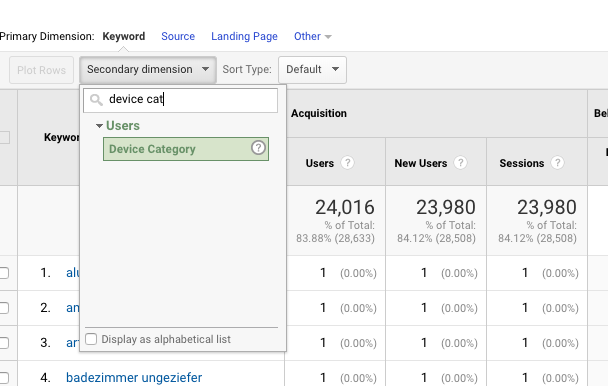Step-by-Step Overview: Leveraging Secondary Dimension in Google Analytics
Step-by-Step Overview: Leveraging Secondary Dimension in Google Analytics
Blog Article
Unlock Deeper Insights With Secondary Dimension in Google Analytics
With the vast expanse of information available in Google Analytics, the use of secondary dimensions can significantly enrich your analytical capabilities. By tactically including second dimensions into your evaluation, you can uncover important insights that might or else continue to be undiscovered - Secondary Dimension in Google Analytics.
Recognizing Primary Vs. Secondary Dimensions
When analyzing data in Google Analytics, it is important to compare secondary and primary dimensions to acquire deeper insights into user habits. Main measurements are the primary classifications through which you can see your information, such as device, touchdown, or source/medium web page. These measurements supply the essential framework for organizing and recognizing your information. On the other hand, second dimensions allow you to more dissect your primary dimension data. By adding a secondary measurement, you can layer on added info to your primary dimension, allowing a much more granular analysis. If your primary dimension is the source/medium via which users got here on your site, including a secondary measurement like geographical location can reveal where those customers are located geographically. This included layer of info can help you identify fads, patterns, or anomalies that might not have actually been obvious when taking a look at the primary measurement alone. Leveraging both main and second dimensions in Google Analytics is critical for extensive information evaluation and notified decision-making.
Using Second Measurements Successfully
By incorporating secondary dimensions along with key measurements, online marketers and analysts can delve deeper right into the specifics of user interactions on their sites. Secondary measurements allow individuals to segment and filter key dimension information further, providing a more detailed sight of customer actions, interactions, and demographics.
Additionally, second dimensions enable individuals to contrast and contrast different data factors within a single record, helping with an extra extensive evaluation of individual actions patterns. By leveraging secondary measurements successfully, companies can discover hidden understandings, maximize their advertising approaches, and improve the total user experience on their websites.
Checking Out Typical Second Dimension Combinations
To additionally assess customer actions and fads in Google Analytics, it is valuable to explore common combinations of secondary measurements. By combining various second measurements, experts and marketing professionals can obtain deeper insights into just how numerous factors communicate and influence website efficiency. Some usual second measurement combinations that supply useful understandings consist of evaluating traffic sources with individual areas to recognize where web site site visitors are coming from geographically and how they located the website. Integrating landing pages with tools can reveal which web pages do best on different devices, helping in enhancing the site for much better customer experience. In addition, examining customer behavior metrics with additional measurements official website such as demographics or rate of interests can aid in targeting specific target market segments extra effectively. By checking out these usual second dimension mixes, services can uncover concealed patterns, determine opportunities for renovation, click here for info and make data-driven choices to enhance their on-line presence.
Using Second Measurement in Personalized Reports
Making use of secondary dimensions in custom-made reports permits an extra detailed evaluation of data in Google Analytics, enhancing the depth of insights gotten. When developing custom records in Google Analytics, integrating second dimensions can offer an extra thorough view of exactly how different measurements connect with each various other. This attribute makes it possible for customers to dig deeper into their data and uncover valuable connections that might not be instantly apparent.
By using second measurements in custom reports, customers can gain a much better understanding of their website or app website traffic. For example, incorporating the primary dimension of "source/medium" with the additional dimension of "touchdown web page" can expose which landing web pages are performing ideal for web traffic originating from specific resources. This understanding can help marketing professionals optimize their projects and improve general conversion rates.

Enhancing Data Visualization With Additional Dimension
When checking out information in Google Analytics custom-made reports, including secondary measurements not just supplies an extra in-depth analysis but additionally improves the visual depiction of understandings with data visualization. By adding a second measurement to your records, you can enhance the method information exists, making it less complicated to identify patterns, fads, and correlations within your internet site's performance metrics.
Second dimensions can assist you sector your data better, enabling a deeper understanding of user actions and interactions on your website. When attempting to isolate certain variables that may affect your website's performance., this enhanced level Clicking Here of granularity can be especially valuable.

Conclusion
To conclude, leveraging second measurements in Google Analytics enables a much more comprehensive analysis of information, resulting in much deeper insights and more enlightened decision-making. Secondary Dimension in Google Analytics. By adding additional layers of info to primary data sets, marketing experts and experts can uncover surprise trends, patterns, and correlations that provide a granular view of user actions and interactions. This improved degree of insight enables optimization of campaigns and customized strategies for specific target market sectors, ultimately boosting performance and conversion rates
On the other hand, additional dimensions permit you to further dissect your key dimension data. By including a second measurement, you can layer on additional details to your key measurement, making it possible for an extra granular analysis. If your main measurement is the source/medium via which customers showed up on your website, including an additional measurement like geographic place can expose where those individuals are situated geographically. By including second measurements along with primary dimensions, analysts and marketing experts can delve deeper into the specifics of customer interactions on their sites. Additional dimensions enable individuals to sector and filter key dimension data even more, supplying an extra thorough sight of user interactions, habits, and demographics.
Report this page